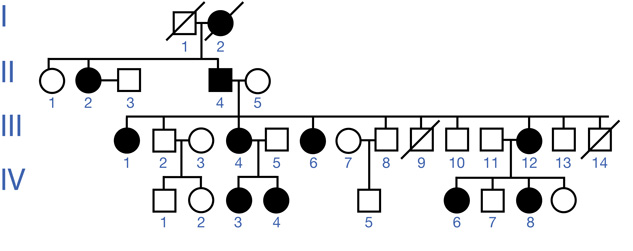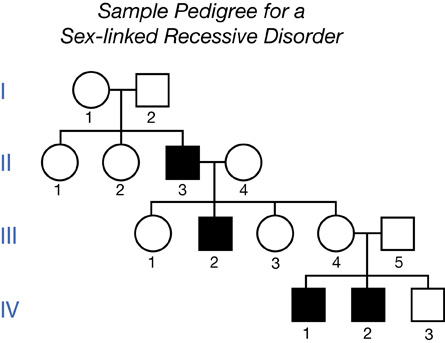Module 6
1. Module 6
1.46. Page 3
Module 6—Mendelian Genetics: The Transmission of Traits to the Next Generation
 Reflect and Connect
Reflect and Connect
Pedigrees display the inheritance of a trait within human populations. They can also be used to predict the likelihood of future offspring expressing a particular trait. This information can be of great benefit to parents considering having children. If you had been Emily or her husband, reflect on what your decisions might have been with regards to having a family. From the biology and technologies that you have learned about throughout this course, consider what your options might have been. Would you decide to prevent conception; if so, how? Or would you take the step to conception, and then use embryo or fetal testing to determine the genetic condition of your child? Based on the results of those tests, what decision would you have made about the pregnancy? If you decided to have a child with a genetic disorder, what impact might this have on the child’s life, and yours?
![]() You might choose to list some of your thoughts on these issues and post them on the Discussion Board. Discuss your thoughts with your teacher and your peers in the discussion area.
You might choose to list some of your thoughts on these issues and post them on the Discussion Board. Discuss your thoughts with your teacher and your peers in the discussion area.
Pedigrees are a valuable instrument in tracing family genetic history. However, there are many societal and ethical issues associated with their use. Nevertheless, genetic counseling is a rapidly developing field of study.
Add new entries to your flash cards on the material regarding pedigrees. Save your completed copy to your course folder. Review your flash cards when you are preparing for your Diploma Exam.
 Self-Check
Self-Check
Apply the concepts you have studied by answering the following Diploma-style questions.
SC 1. Hereditary diseases have diverse causes. For example, the disease mutation may be dominant or recessive; or the mutated gene may be present on the X chromosome or on an autosome. In some cases, similar diseases are caused by mutations in two different genes. One such case is ALD, where one gene is autosomal and the other is X-linked. In both forms of inheritance, the disease mutation is recessive. Scientists continue to research the causes of ALD. The X-linked recessive form of ALD can be diagnosed prenatally.
Adrenoleukodystrophy (ALD) is a rare disease of the central nervous system. ALD is characterized by the accumulation of very-long-chain fatty acids in the white matter of the brain and in the adrenal glands. Symptoms start with tantrums and other behavioural problems; then motor function, speech, and hearing are impaired; and finally blindness, mental deterioration, and death occur.
Describe one piece of evidence obtained from the analysis of a pedigree chart that could be used to determine whether the mode of inheritance of a human genetic disorder is X-linked or autosomal, and one piece of evidence that could be used to determine whether it is recessive or dominant. Construct a pedigree of four generations that clearly illustrates one of the two types of inheritance of ALD. Clearly label where your pedigree shows evidence of X-linked recessive or autosomal recessive inheritance.
SC 2. Larry and Danny Gomez, two boys known as “Wolf Boys,” have made the circus their adoptive family. Both boys perform as trampoline acrobats, and Danny also does motorcycle stunts. The boys have a condition called congenital hypertrichosis (CH), which is a very rare X-linked dominant inherited condition. CH is characterized by the growth of dark hair over the body, particularly on the face and upper torso in males. The palms of the hands, soles of the feet, and mucus membranes are not affected by this condition. A press release about the circus stated that Larry and Danny have travelled to many countries in search of a cure. When asked about the search for a cure in an interview by David Staples of The Edmonton Journal (May 14, 1997), Larry said, “I’d never take it off. I’m very proud to be who I am.” Outside the circus, the boys enjoy activities typical of most boys their age. Danny likes to play video and board games, and Larry is interested in science and is taking astronomy by correspondence.
The incidence of CH is very rare: only about 50 affected individuals have been reported since the Middle Ages. The incidence of this condition is considerably higher in a small Mexican village than it is in the rest of the human population. In 1984, researcher Macias-Flores studied CH in a large, five-generation Mexican family and found 19 individuals with CH. A partial pedigree showing the sampled individuals from the Macias-Flores study is shown below.

Identify the genotypes for individuals II-4, II-5, III-11, III-12, IV-6, IV-7, IV-8, and IV-9 in one of the lines of inheritance on the pedigree. (Provide a key for the allele symbols you use.) Construct a Punnett square to predict the probability of individuals III-11 and III-12’s next child being a male with CH. Explain why more females than males inherit CH in generation III.
Use the following information to answer the next three questions.
Deaf-mutism is an autosomal recessive trait that is caused by two genes. Individuals who are homozygous recessive for either gene will have deaf-mutism. The two genes are designated as D and E in the diagram below.

SC 3. Which of the following is a possible genotype of individual IV-3?
- ddEE
- ddEe
- DDee
- DdEe
SC 4. Individuals III-1 and III-2 are expecting their seventh child. What is the probability of this child having deaf-mutism?
- 0.00
- 0.25
- 0.50
- 0.75
Numerical Response
SC 5. What is the probability of a couple that are heterozygous for both genes having a child with deaf-mutism?
 Self-Check Answers
Self-Check Answers
SC 1.
Evidence of X-linked inheritance (autosomal):
- A greater number of males than females have the disorder. (The number of males and females with the disorder is roughly equal.)
- The disorder appears to be inherited from the maternal side of the family. (The disorder appears to be inherited from either gender parent equally.)
Evidence of recessive inheritance (dominant)
- Two parents without the disorder have a child with the disorder. (Two parents with the disorder have a child without the disorder.)
- The disorder skips generations. (The disorder is present in each generation or disappears completely from successive generations.)

Labelling of this pedigree should indicate the following evidence:
This pedigree does not show any evidence that males or females inherit the disease more often, so there is no evidence that it is sex-linked. The first generation (parents) do not have the disorder but two of their children have the disorder. This indicates that it is a recessive disorder which is not expressed in the parents who are carriers of the disease allele.

Labelling of the pedigree should indicate the following evidence:
This pedigree shows evidence that males inherit the disorder more often than females. This is consistent with a disease allele that is carried on the X chromosome. It is recessive since II-3 does not pass on the disease to any of his daughters, even though they would have a copy of his X chromosome with the disease allele.
SC 2.
Genotypes:
II-4: XCY
II-5: XcXc
III-11: XcXY
III-12: XCXc
IV-6: XCXc
IV-7: XcY
IV-8: XCXc
IV-9: XcXc
Alleles:
XC-CH
Xc-normal

- Probability of III-11 and III-12’s child being male with CH
(male with CH) XCY = or 25%
or 25%
- More females than males inherit CH in generation III because individual II-4, a male, has CH and, because CH is X-linked dominant, the father's XC will be passed on to all his female children in generation III (but not to his sons who received the father's Y chromosome).
SC 3. D
SC 4. A
SC 5. ![]()
 Reflect on the Big Picture
Reflect on the Big Picture
By building a pedigree of a real family, you have put into practice your knowledge of genetics. You can now visually display inheritance and appreciate how a pedigree can be used to analyze inheritance of a trait through a family’s history. You better understand how traits can be traced through your family, and you can understand how the variety and similarities are expressed in your family.
 Module 6: Lesson 10 Assignment
Module 6: Lesson 10 Assignment
Submit your completed Module 6: Lesson 10 Assignment to your teacher for assessment.
Before beginning your Module Assessment, you may choose to do a selection of questions from page 606 and page 609 of your textbook. Discuss your responses with your teacher.
Review and complete your choice of Module Assessment and submit your work to your instructor.
Remember you also have the option of trying additional questions from the textbook for further practice. Consult with your teacher for the answers to these questions. The Key will also provide you with many Diploma Exam-style multiple-choice, numerical-response, and written-response questions that will be an excellent review of the module. Practising your responses to these types of questions is good preparation for the Diploma Exam.